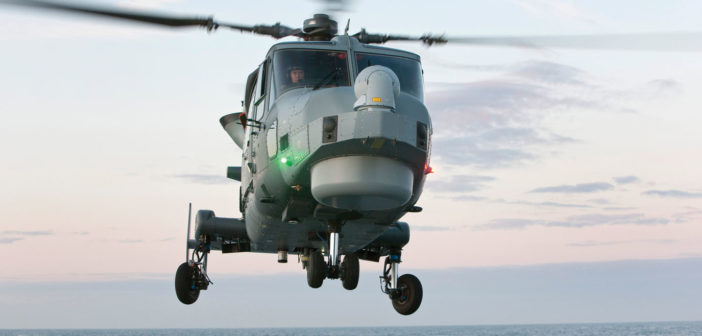– By Andrew White –
Following nearly two decades of campaigns conducted in the permissive RF threat environments of the Middle East and Afghanistan, European armed forces are shifting more attention to regional priorities, especially requirements that address so-called near peer and high capability adversaries. Nowhere is this emerging threat more apparent than in eastern Europe, where Russia and its allies have been steadily fielding new air defense systems, including those deployed with its armor and artillery units. In response, NATO partners are seeking to upgrade the electronic warfare (EW) capabilities of their rotary-wing assets to bolster their survivability in the more complex and dangerous threat environments along NATO’s eastern border.
In July, the Polish Ministry of National Defence will initiate a strategy to upgrade its legacy inventory of helicopters with next-generation self-protection and EW mission suites. Upgrades, which will initially focus on Mi-24D helicopters, are due to be undertaken between July and September 2019, with technology enhancements potentially being transitioned into more modern air frames, including the newly acquired S-70i Black Hawk and candidate aircraft being considered as part of the Kruk program. This is just one of many emerging helicopter EW programs around Europe which is calling for scalable and modular EW mission suites. In this article, we will take a look at the helicopter EW market across Europe and what types of Aircraft Survivability Equipment (ASE) solutions the region’s EW companies are offering.
THE SWEDISH-SOUTH AFRICAN CONNECTION
According to Saab’s product manager for airborne self-protection, Martin Vosloo, rotary-wing air frames offer armed forces a versatility not afforded by many fixed-wing aircraft, thereby making them an “integral” part of any military operation or campaign.
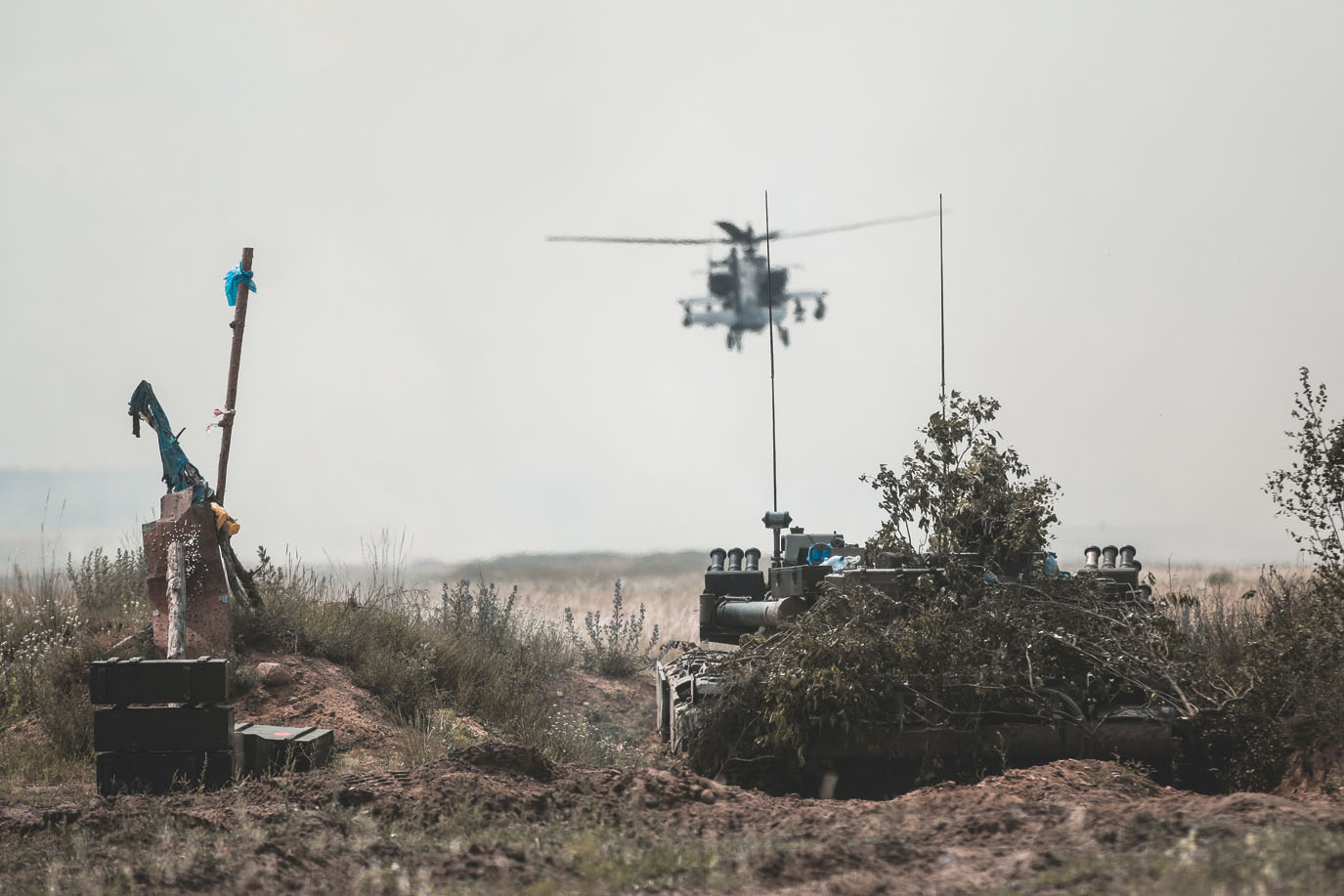
Reflecting emerging requirements from the contemporary operating environment in eastern Europe, a US Army AH-64 Apache helicopter works alongside a Polish army PT-91 Twardy main battle tank during Exercise Saber Strike 18 at Bemowo Piskie Training Area, June 15, 2018. – DVIDS
Speaking to JED, Vosloo described how the availability of “supportive and defensive countermeasures” for helicopters continues to emerge as an increasingly important component to the protection and mission success of military platforms operating in a complex battlefield environment, which is witnessing proliferating levels in radar-, laser-, and infrared (IR)-guided missile threats.
“Missions for combat search and rescue, surveillance and troop transportation are usually not conducted anymore without the availability of a serviceable defensive aids system,” Vosloo explained, before outlining an emerging pattern of “need-based” replacement and acquisition upgrades across the military rotorcraft market.
“The presence of an ageing aircraft inventory has led to an increased focus on military forces upgrading their fleets with the latest technologies. Competing budget needs should see militaries compelled to invest in upgrading and modernizing their helicopter fleets to increase the service life of the existing rotary-wing aircraft,” he warned.
Observing specific operating requirements across eastern Europe, Saab has noticed a definitive trend away from a focus on protection from shoulder-launched IR-guided missiles toward greater awareness of radar threats from upgraded ex-Soviet weapon systems equipped with modern processing capabilities.
“The advent of digital processing allows for upgrading of those deployed systems with upgraded capabilities,” he explained. “In terms of laser threats, a growing presence of beam-rider missile systems have been noted, which in turn necessitates the use of suitable sensors for detecting these challenging systems due to their method of operation.”
He further explained, “So the trend has become for forces to install defensive aids against all known threats. For example, where the threats used to be ‘undefined,’ forces are now preparing themselves more against known threats.”
Saab’s family of protective solutions includes the Integrated Defensive Aids Suite (IDAS) family of products, which has been designed to enhance the survivability of aircraft across “sophisticated, diverse and dense” threat environments. Comprising a fully integrated, multi-spectral self-protection capability, IDAS provides air crews with tactical situation awareness and early warning of threat activity, which can, in turn, reduce the workload and stress levels of operators, allowing them to concentrate on the core mission.
The IDAS family of solutions includes the IDAS-3 and Compact IDAS (CIDAS). According to Vosloo, CIDAS comprises a smaller and lighter weight variant featuring just EO sensors and a smaller control unit, specifically designed to protect air frames against IR-guided and laser-based threats, many of which are encountered in the currently prevailing peacekeeping environment.
Both IDAS-3 and CIDAS solutions feature the LWS-310 laser warning system, which operates across the 0.5-1.7nm wavelength range to provide threat classification and direction of arrival for laser rangefinders, designators and missile guidance lasers. A total of four laser warning sensors provide a helicopter with 360-degree coverage, with up to six sensors used to provide similar coverage for larger air frames.
Also integrated into IDAS-3 and CIDAS is the MAW-300 missile approach warning system, which features a series of passive ultraviolet (UV) sensors that are capable of detecting and processing multiple targets simultaneously and disseminating data to an EW controller, where information is integrated with inertial navigation systems (INS) information to compensate for platform movement, attitude and altitude. A total of four MAW-300 sensors must be integrated to provide 360-degree protection of an air frame, Saab confirmed.
IDAS-3 and CIDAS, both of which can be upgraded with Digital Receiver (DRx) technology, can also be integrated with Saab’s BOP-L advanced lightweight countermeasures dispensing system.
Describing the IDAS’s modular system architecture, Vosloo also explained how the various sub-systems within IDAS-3 and CIDAS could be reconfigured for specific mission types. To date, IDAS variants have been integrated on rotary-wing air frames including Oryx, Puma, Cougar/Super Puma, Rooivalk, A109, Super Lynx 300, Dhruv, Chinook and H225M.
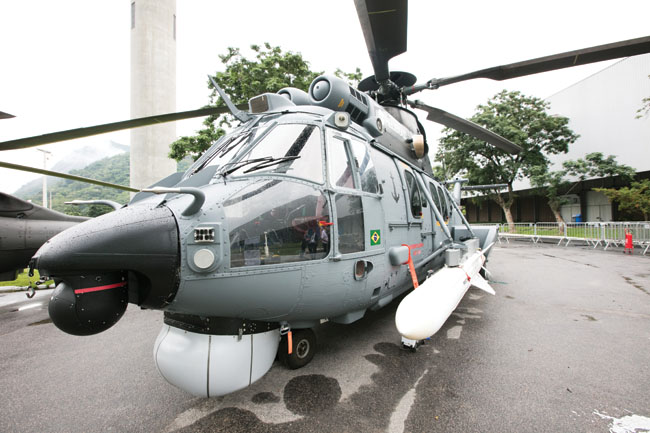
Saab’s Integrated Defensive Aids Suite (IDAS) family of products has been designed to enhance the survivability of aircraft across “sophisticated, diverse and dense” threat environments. – Saab
As Vosloo explained, Saab remains focused on improving a series of capabilities to enhance the protection capabilities of rotorcraft in the future. Areas of interest include improved radar warning in the presence of communication signal noise and continuous wave (CW) signals; New-technology digital receivers, providing improved performance in respect of sensitivity and frequency channelization allowing improved detection capability against new-generation RF threats in environments with lots of radio frequency (RF) noise; and finally, improved UV missile warning performance capable of detecting old- and new-generation IR-guided threats.
Saab also continues to enhance countermeasure dispensing capabilities with smart and adaptive technology, as well as improved laser warning technology designed to assist in protection levels against new-generation laser threats, including beam riders. Saab also explained how it plans to further optimize Hostile Fire Indication capabilities, using both passive and active technologies, against small arms fire and rocket propelled grenades (RPGs).
ITALIAN INGENUITY
According to Elettronica’s corporate chief scientist, Daniela Pistoia, helicopters remain the most exposed military asset in both traditional and emerging conflict scenarios.
“Budget-concerned customers are reasoning according to platform role, and this approach is defining specific self-protection capability and cost procurement plans,” she explained to JED while describing how requirements can range from standard self-protection suites for utility helicopters through to high-end, multi-spectral solutions for attack or Combat Search and Rescue (CSAR) helicopters.
Discussing existing threat profiles associated with the contemporary operating environment, Pistoia explained how both guided- and non-guided weapon systems had not changed much over recent years. However, what has changed, Pistoia warned, is the movement toward a more contested electromagnetic spectrum, where the enemy is using all possible means to degrade friendly combat capabilities through a mix of hybrid or information warfare.
“All scenarios, including urban environments, require a very fast EOB recognition,” Pistoia explained, before describing how unmanned aerial vehicles (UAVs), operating in swarms or as loitering munitions, also represent a new threat to rotary-wing air frames.
Seeking to overcome many of these emerging operational requirements, Elettronica has identified RF and EO enhancements to legacy protection systems.
Solutions include gallium nitride (GaN) and Quantum Cascade Laser (QCL) technologies which, according to Pistoia, are capable of supporting existing systems in self-protection electronic attack (EA); all-signal processing innovations for EW support and specific emitter identification; low-probability-of-intercept (LPI) detection; and adaptive (i.e., machine learning) solutions.
“This is enabled by analog-to-digital wideband conversion and artificial intelligence,” Pistoia said. However, she warned, “What should not be overlooked is the importance of the networking technology that allows a multi-platform EW layer of real-time and overall EOB awareness and electronic attack. This represents a big step ahead: The technology is mature, but what needs to be worked on is the doctrine and the connectivity.”
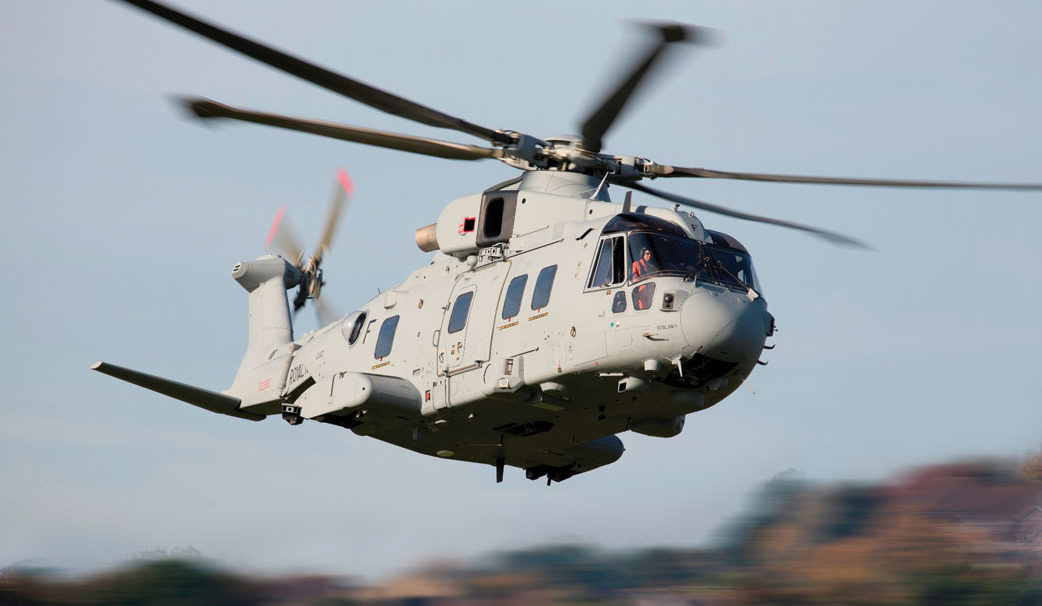
AgustaWestland’s AW101 continues to be upgraded with EW mission suites, including Elettronica solutions for the Italian Air Force’s CSAR platform. – Leonardo
Elettronica’s helicopter EW solutions include the Virgilius Integrated System, which comprises a multifunction unit equipped with DF antennas, low-band solid-state transmitters, and medium-band and high-band active phased array transmitters, providing simultaneous ESM and ECM capabilities.
Virgilius supports RF emitter recognition in high-density electromagnetic environments, multi-threat jamming against simultaneous threats, direction finding and passive location, and acquisition and tracking of sidelobe emissions, Pistoia explained.
Elettronica has also designed the ELT-572 directed infrared countermeasures (DIRCM) system, which features a mirror turret, laser generator unit and an electronic control unit, which can be integrated with missile warning systems to provide end users with rapid reaction to multiple and simultaneous MANPAD threats.
Both Virgilius Integrated System and EO ELT-572 Direct Infrared Countermeasure (DIRCM) active and passive countermeasure technologies are already integrated onboard the Italian Air Force’s CSAR AW-101 helicopter. According to Pistoia, integration remains ongoing with the solution currently installed and undertaking flight tests onboard the AW101 helicopter.
Elettronica also confirmed how the latest ELT162 multispectral EW system and ELT-600 DIRCM have already been made available to customers. Featuring a newly designed form factor, the ELT-600 DIRCM, designated EuroDIRQM and currently in development with Spanish EW company Indra, provides end users with protection against any IR-guided threat based on thermal trackers up to 3rd generation (signal processing-based seekers) and up to 4th generation when in cooperation with flares. Supported by QCL technology, the EuroDIRQM can also be integrated with a solid-state multi-band high-power laser to further extend protection levels while also providing jamming on target within 700m/sec of a threat declaration from a missile warning system. Pistioa added that the ELT-600 can also be integrated onboard any large body helicopter also equipped with a legacy self-protection suite.
SMART SUITES FOR THE UK
According to Kyle Alexander, head of EW rotary campaigns at Leonardo, platform protection also remains a critical capability requirement for military helicopters in the contemporary operating environment.
Describing how most rotary-wing upgrade and new build procurement programs now include some kind of EW requirement, Alexander highlighted to JED how capabilities demanded would depend upon expected mission tasks and areas of operation for the platform in question.
“MANPAD missile warning and countermeasures (flare dispensing or DIRCM) remain a core requirement for ‘low and slow’ aircraft such as helicopters,” he explained. “As potential operating environments develop, requirements for RF sensors and effectors are increasingly common, as are systems that will address latest generation threats and Integrated Air Defense Systems (IADS).”
However, Alexander observed, evolving threats continue to drive EW requirements, which continue to be fulfilled through the parallel development of sensor and countermeasure capabilities. “Sensor development is required to be able to accurately detect signature and launch events, while countermeasure development is required to successfully address new-generation systems and IADS,” he said.
Leonardo’s helicopter EW offerings include the SEER radar warning receiver (RWR) which has been designed to provide “highly accurate, high-fidelity and instantaneous threat detection and aircrew notification.” Available in E- to J-, C- to D- and E- to K-band configurations, SEER can be integrated into legacy multimission displays to assist air crew in the identification and reporting of radar threats. Comprising an 11kg payload, SEER supports direction finding at less than 10 degrees RMS, while pulsed/pulsed Doppler/CW technology supports the detection of threats. The solution is also equipped to support mission recording capacity for up to 20 hours.
Another Leonardo offering, the SAGE ESM system, has been designed to provide growth potential toward more strategic EW intelligence gathering and analysis of the EW/threat environment whilst maintaining tactical threat awareness. Featuring a series of direction-finding antennas, SAGE features a dual-role ESM/RWR, allowing it to “pinpoint” targets; identify weapon systems; and enable users to discern tactics, techniques and procedures of enemy forces as well as cueing external sensors, jamming and electronic attack systems. Operating from 0.5 GHz to 40 GHz, SAGE provides a one-degree direction finding accuracy according to the company.
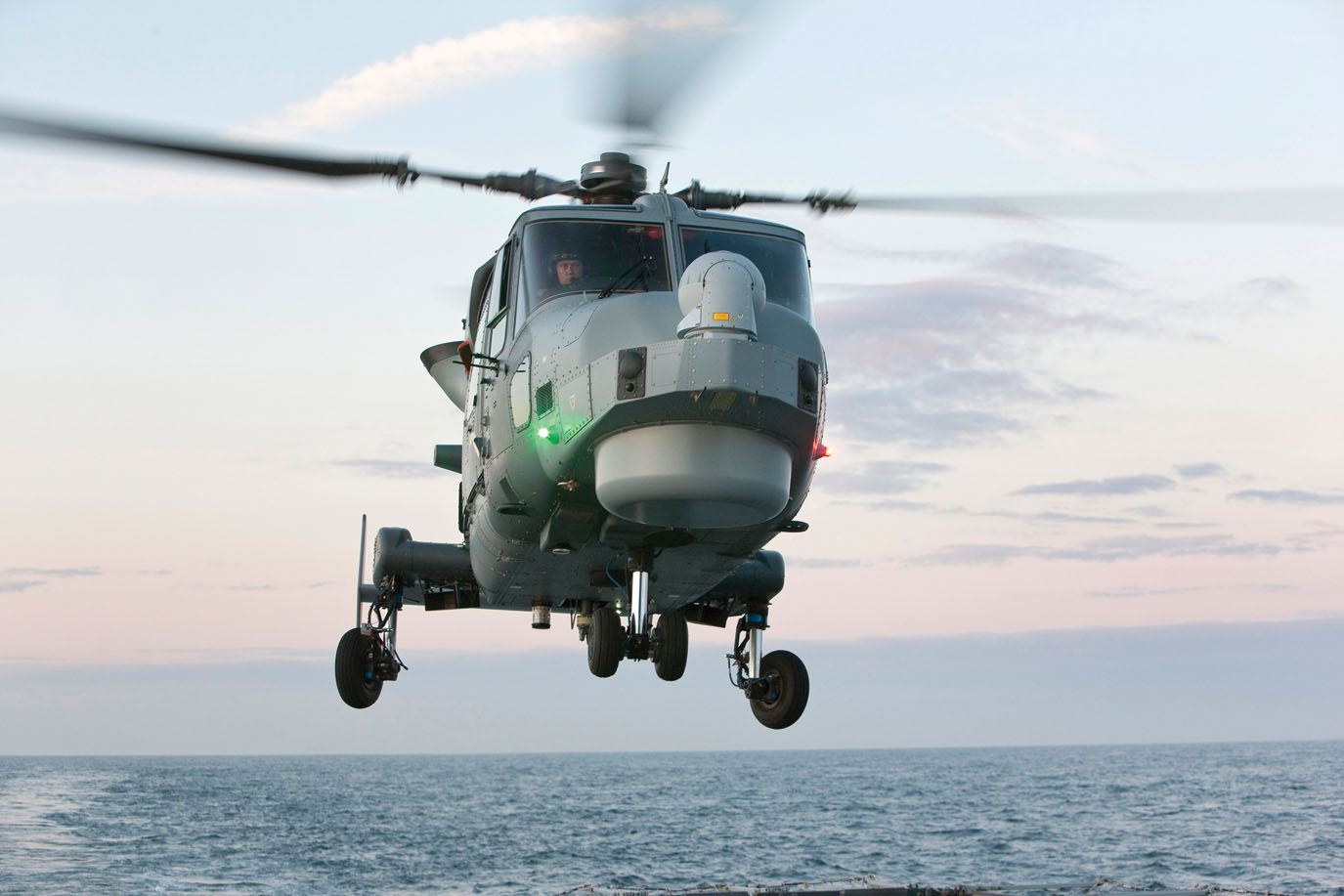
One of the UK Royal Navy’s latest rotary wing platforms – the AW159 helicopter – is fitted with Leonardo’s SAGE ESM solution. – Leonardo
Leonardo also offers the Miysis DIRCM, which provides full spherical coverage against advanced IR threats. Miysis DIRCM has been designed with a modular and open architecture design, which allows for its integration with a customer’s in-service missile approach warners and other defensive aids systems.
SAGE and SEER are supported by Leonardo’s EW Operational Support (EWOS) tools for mission data programming and replay. Such a capability, Alexander continued, allows armed forces to optimize the utility of SAGE as well as providing the ability to independently update the system to recognize new threats as they arrive in theater.
According to Leonardo, the wider integration of these various sub-systems into an “Intelligent IDAS” increases survivability levels of an air frame through data correlation and mission management, reduced aircrew workload, prioritization of threats and cueing of the most effective countermeasures.
“Our work to integrate the latest sub-systems into our IDAS offering includes partnering with Thales to integrate their Elix-IR Threat Warning System with our Miysis DIRCM and developing our capacity to work with forthcoming smart countermeasure dispensers,” Alexander explained. He also noted the launch of Leonardo’s BriteCloud 55-T Off-Board Expendable Active Decoy in 2018, which is also suitable for rotary wing platforms.
Leonardo continues to supply Boeing and the US Army with delivery of the Aircraft Gateway Processor (AGP) in support of the AH-64 Apache program. According to Alexander, every AH-64 which comes off the Boeing production line for all customers now features an integrated the AGP DAS computer, which he describes as the EW controller for the ASE suite. Elsewhere, Leonardo is also contracted to support the British Army’s fleet of AH-64E Apaches with EW protection equipment. The news follows an April 2018 contract from the UK Ministry of Defence tasking Leonardo to provide DAS for the British Army’s inventory of Apaches.
In addition to the built-in Leonardo AGP, the company is integrating the SG200-D radar warning receiver (the UK-specific variant of the company’s SEER family) and is re-using a number of systems that are currently onboard the British Army’s fleet of Apache AH Mk1, including Leonardo’s S1223 laser warning receiver, the AN/AAR-57 Common Missile Warning System from BAE Systems and the Thales Vicon countermeasure dispensing system. Existing UK Apache AH Mk1 helicopters are equipped with the company’s Helicopter Integrated Defensive Aids Suite (HIDAS) system. Leonardo also provides HIDAS to the British Army and Royal Navy AW159 Wildcat helicopters.
Leonardo is also contracted to retro-fit the UK MoD’s inventory of CH-47 Chinook helicopters, including the latest HC Mk 6, with DAS technologies. Under this project, Leonardo has combined all of the Chinook’s existing sensor and effector systems into an integrated system that offers suite management capabilities similar to the HIDAS system. Comparable upgrades have also been made to the UK’s Puma and Merlin fleets, Alexander added. Similar to the Apache AH-64E, both Royal Air Force Puma and Chinook fleets are also receiving updated radar warning capabilities in the form of Leonardo’s SG200-D RWR.
GERMANY PUSHES EW DEVELOPMENT
Germany’s Hensoldt sees helicopters challenged by a variety of threats, including laser-guided missiles, IR missiles, radar-guided missiles, rocket-propelled grenades and tracer munitions. The company notes that a significant number of helicopters worldwide are still either unprotected or have gaps in their protection level.

The MILDS AN/AAR-60 MWS is designed to detect, track and provide warning of threatening missiles at maximum range. – Hensoldt
As a result, Erich Wagenbauer, head of self-protection sales at Hensoldt, explained how the company is seeking to assist customers aiming to overcome many of these existing capability gaps. Areas of interest include protection against MANPADS and rocket propelled grenades (RPGs) by reliable missile warning and Hostile Fire Indication systems, as well as protection against laser-guided threats, including target designators and laser beam-riding missiles.
Hensoldt’s product manager for electronic support, Frank Kessler, explained, “Conventional radar warning receivers cannot cope with new radar threats such as LPI radars [radars with complex intra-modulation using wider frequency ranges]and congested spectrum [expansion of mobile communications signals requires more sophisticated digital spectrum monitoring].”
Hensoldt solutions include the Airborne Missile Protection System (AMPS), which is capable of accommodating a variety of warning sensors, countermeasures and avionic equipment to protect rotorcraft from IR, laser or radar guided missiles.
The AMPS is capable of supporting UV missile warning systems as well as active confirmation sensors which have been designed to “virtually” eliminate false alarms at a systems level, Hensoldt officials said.
“We are working on a combination of a passive MWS (MILDS) and an active confirmation sensor to provide reliable detection of RPGs fired against helicopters,” Wagenbauer described while confirming how Hensoldt’s UV MWS could be used in an HFI function to detect hostile fire without requirement for additional sensors and equipment.
The MILDS AN/AAR-60 MWS is designed to detect, track and provide warning of threatening missiles at maximum range, including rapid discrimination of stationary and moving UV point sources. This, according to Wagenbauer, supports operations in urban environments with a minimal false alarm rate. MILDS, which can also feature HFI technology, can also support multi-threat handling of up to eight targets per system, it was added. Wagenbauer said that Hensoldt EW equipment is already installed on more than 20 helicopter platform types, including the H135M, H145M, H215, H225, UH60, CH-47, Bell 407, CH-53 and Mi-17 air frames.
Seeking to future-proof its technology, Hensoldt is also in the process of developing a new generation of fully digital radar warning receivers which, Kessler claimed, will be able to handle “all current scenarios and provide inherent growth potential by means of artificial intelligence methods.” A new product will be introduced into the market before the end of the second quarter of 2019, Hensoldt confirmed.
SPAIN’S QUEST FOR SPECTRUM DOMINANCE
Finally, Spanish company Indra has identified a growing market in self-protection and sensor technology for helicopters, which can be associated with current utility of helicopters as well as an “eruption” in new designs of Vertical Take-Off and Landing (VTOL) capabilities, including unmanned aerial vehicles (UAVs).
As Raul Pajarin, responsible for the airborne segment within Indra’s platforms business line, described to JED, “big and slow” helicopters require greater levels in self-protection across an increasingly contested operating environment.
“For rotary-wing platforms, self-protection capabilities are subject to improvements because these types of platforms are an easier target compared to other platforms. Also, communications is an area of big improvement, with more bandwidth of operation for data links, more immunity against interference, better crypto-protection and permanent connection (including satellite comms) demanded.”
According to Indra, spectrum dominance will play a major role in future helicopter requirements. Hence the reason why the company remains focused on the “direct digitization of the environment at sensor level (including Radar, IR and communications) in order to provide a full instantaneous view and immunity against all kinds of interference, especially for helicopters or slow motion rotary wing platforms in urban areas.” Also identifying its co-developed EuroDIRQM with Elettronica as an improved self-protection solution based on QCL technology, Indra remains focused on the miniaturization of sub-systems to reduce size, weight and power.
Working in close collaboration with the Spanish MoD, Indra continues to research radar mission systems for rotary wing platforms which, according to the company, are close to entering the market. Indra solutions include an EWS system for a range of helicopters, including NH90, Tiger, Cougar, Chinook (Spanish MoD), Cougar and CH53GA in Germany.
LOOKING TO THE FUTURE
Beyond urgent operating requirements associated with the contemporary battlespace, European industry players are also considering the future of the rotary-wing self-protection solutions.
As Saab’s Vosloo explained: “We foresee EW becoming standard fit for an increased number of military platforms, and not only for special-mission rotary-wing aircraft, due to the threat environment. This will also drive an increase in replacing and upgrading legacy EW systems with new systems.”
Looking further ahead, European market players are paying significant attention to increased networking capabilities between multiple platforms and sensors across a single battlespace. As an example, Vosloo highlighted how “sensor fusion” over multiple platforms will enhance capabilities to increase levels in detection accuracy. Similar observations were echoed by Elettronica’s Pistoia, who described how Manned-Unmanned Teaming (MUM-T) concepts of operation would also assist a future “breakthrough” for rotary wing self-protection systems.
Finally, Leonardo’s Alexander predicted an increase in RF sensor and countermeasure requirements, driven by threat system development and proliferation.
“To understand and address a complex and congested threat environment, there will be an increase in intelligent system linking and the utilization of data. We are expecting to see increased utilization of open-architectures and ‘app-able’ software which will provide flexibility with minimal integration, qualification and certification effort,” he concluded. ♦
If you enjoyed this article, please share. If you would like to read more articles like this one, we encourage you to join the AOC to receive a copy of JED every month.

